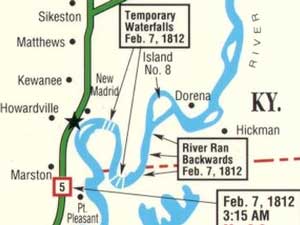The mississippi river once started flowing backwards after an earthquake

The Mississippi River’s Unprecedented Backward Flow: A Fluvial Tsunami Caused by an Earthquake

The Mississippi River, famously known as the “Father of Waters,” holds a prominent place in the heart of America. Its steady flow from north to south has been the lifeblood of numerous cities, connecting communities and providing resources for centuries. However, on the fateful day of December 16, 1811, the mighty Mississippi showcased its incredible power in an astonishing and unprecedented manner. A massive earthquake triggered a fluvial tsunami, causing the Mississippi River to flow backward.
This extraordinary event, now etched in history, originated from New Madrid, a small town located in the heart of Missouri. The town’s name has become synonymous with one of the most powerful and destructive earthquakes to ever strike North America. The earthquake, estimated to be 7.8 on the Richter scale, sent shockwaves radiating across thousands of miles, impacting a vast area.

As the earth convulsed beneath, the earthquake abruptly shifted the course of the river, forcing it to temporarily flow backward. Witness accounts from that time described the surreal sight of the river meandering in reverse as if defying the laws of nature. The immense power of the earthquake created an unprecedented hydraulic anomaly, causing the fluvial tsunami that pushed the Mississippi River to change its direction.
This extraordinary occurrence startled the inhabitants of the region. Native American tribes, the few settlers, and even wildlife found themselves perplexed by the inexplicable phenomenon. The Mississippi River, known for its predictability and unwavering course, had suddenly become an unpredictable force of nature.
While the earthquake-induced backward flow of the Mississippi River was a mesmerizing sight, the consequences were far from fascinating. The fluvial tsunami led to catastrophic damages along the riverbanks, wiping out entire settlements and obliterating landmarks. The sheer magnitude of the event disrupted the lives of countless individuals who depended on the river, leaving them bewildered and struggling to comprehend the extent of the disaster.
Although the Mississippi River eventually returned to its traditional flow, the impact of this extraordinary event lingers to this day. Scientists and researchers dedicate their efforts to further comprehend the mechanics behind the New Madrid earthquake and the subsequent fluvial tsunami. Understanding these events offers crucial insights into the seismic history of the region and aids in developing strategies to mitigate the potential devastation of future earthquakes.
The Mississippi River’s backward flow, triggered by the powerful New Madrid earthquake, serves as a reminder of the awe-inspiring forces that shape our planet. This extraordinary event showcases the resilience of nature and the profound impact it can have on human lives and communities. As we marvel at the normalcy of the Mississippi River’s current course, we cannot help but be reminded of the remarkable day when it flowed backward, defying expectations and leaving an indelible mark on history.
References:
Related Posts
Quick Links
Legal Stuff

